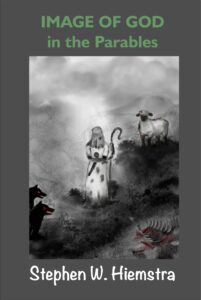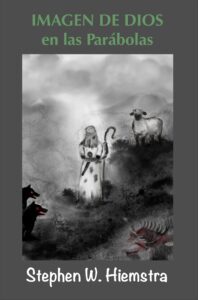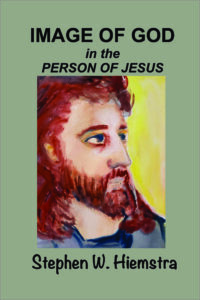Stephen W. Hiemstra's Blog, page 39
August 9, 2024
The Face of God in the Parables

The LORD passed before him and proclaimed,
The LORD, the LORD, a God merciful and gracious, slow to anger,
and abounding in steadfast love and faithfulness.
(Exod 34:6)
By Stephen W. Hiemstra
The image of God in the New Testament takes three forms: The person of Jesus, Jesus’ teaching about the kingdom of God with the parables, and the founding of the church on Pentecost by the Holy Spirit. This is a trinitarian revelation of God, not by words, but by action. Here I will focus on the image of God the Father found in the parables.
The authenticity of the parables as Jesus’ own words are seldom questioned, in part, because Jesus’ parables are unique, a genre unto themselves. The parables invite the hearer to participate in the story and require a response to the call to faith, many times without explicitly mentioning God.
Circumlocutions
Explicit in some parables and implicit in others are the words: The kingdom of God is like… Because the covenantal name of God, YHWH, is sacred in Jewish thought, the Bible uses numerous circumlocutions—indirect references—for God’s name. The most common circumlocution is Lord, which in Hebrew is Adoni. Another common circumlocution is The Name, which in Hebrew is Shem.
Indirect speech, like poetry, is most common in repressive societies. Jesus began speaking in parables after the Pharisees began to plot against him (Matt 12-13). In this sense, a parable is an elegant form of circumlocution.
New Testament references to the Kingdom of God (Mark, Luke) or the Kingdom of Heaven (Matthew) are circumlocutions for the name of God. Almost all of Jesus’ parables refer to the kingdom of God, while rabbinic parables typically elucidate a passage of scripture (Blomberg 2012, 77).
God’s Self-Revelation
Because we are created in the image of God (Gen 1:27), it is important that we understand what God’s image implies. After the second giving of the Ten Commandments, Moses is given a description in Exodus 34:6, cited above, of who God is that is repeated throughout the Old Testament (Ps 86:15, 103:8; Joel 2:13; and Jonah 4:2).
This latter reference is interesting because Jesus described his mission in these words: “For as Jonah became a sign to the people of Nineveh, so will the Son of Man be to this generation.” (Luke 11:30) If Jesus knew the story of Jonah, he most clearly knew Exodus 34:6 because Jonah’s reason for running away from Nineveh hinged on it: “That is why I made haste to flee to Tarshish; for I knew that you are a gracious God and merciful, slow to anger and abounding in steadfast love, and relenting from disaster.” (Jonah 4:2). Jonah hated the Ninevites and refused to preach God’s forgiveness them because he knew God would forgive them if they repented of their sin.
These five characteristics of God—mercy, grace, patience, love, and faithfulness—therefore provide a powerful classification for Jesus’parables. A sixth classification—the response and characteristics of disciples—provides another obvious classification for many parables.
Jesus’ Authority
Why is Jesus an authority on the image of God? Christ’s death on the cross and resurrection credential his link to God as the author of our faith (1 Cor 15:20-28; Heb 12:2). In fact, because the New Testament was written after the Christ’s death and resurrection, every sentence in the New Testament should be read as if pre-pended with the words: Because Christ rose from the dead, therefore…
The parables of Jesus therefore read as if penned by God himself, something worthy of further study.
References
Blomberg, Craig L. 2012. Interpreting the Parables. Downers Grove: IVP Academic.
Kreeft, Peter. 2007. The Philosophy of Jesus. South Bend, IN: Saint Augustine Press.
The Face of God in the Parables
Also see:
The Who Question
Preface to a Life in Tension
Other ways to engage online:
Author site: http://www.StephenWHiemstra.net
Publisher site: http://www.T2Pneuma.com
Newsletter at: https://bit.ly/Staycation_24, Signup
The post The Face of God in the Parables appeared first on T2Pneuma.net.
El Rostro de Dios en las Parábolas

Entonces pasó el SEÑOR por delante de él y proclamó:
El SEÑOR, el SEÑOR, Dios compasivo y clemente, lento para la ira
y abundante en misericordia y verdad (fidelidad);
(Exod 34:6)
Por Stephen W. Hiemstra
Nuestra imagen de Dios revela no sólo el carácter de Dios, sino también el nuestro. Las parábolas revelan a un Dios que está intencionalmente disponible para quienes lo buscan. Invitan al oyente a entrar en la narrativa e interactuar con Dios uno a uno para ampliar nuestra comprensión de la fe y de nosotros mismos.
La imagen de Dios en el Nuevo Testamento toma no minus de tres formas: la persona de Jesús, la enseñanza de Jesús sobre el reino de Dios en las parábolas, y la fundación de la Iglesia en Pentecostés por el Espíritu Santo. Esta es una revelación trinitaria de Dios, no mediante una descripción analítica, sino a través de imágenes verbales. En este libro me centraré en la imagen de Dios Padre que se encuentra en las parábolas.
La autenticidad de las parábolas como palabras del propio Jesús rara vez se cuestiona, en parte porque las parábolas de Jesús son únicas, un género en sí mismas, pero no un género típico. Un género típico puede adherirse a una estructura o forma de historia particular, pero no una parábola. Las parábolas se distinguen por invitar al oyente a participar de la historia y exigir una respuesta al llamado a la fe, muchas veces sin mencionar explícitamente a Dios.
Esta invitación a entrar la presencia de Dios es inesperada y contraria de nuestra experiencia. La narrativa es más que la suma de las partes, como un amanecer de Pascua que transforma todo lo demás. La frescura del evento nos sorprende, incluso nos provoca, al ver todo nuevo. Es como escalar una montaña para descubrir que vives en una isla, pero la buena noticia es que en el horizonte hay un mundo completamente nuevo accesible a través de la fe. Los viejos límites ya no se aplican. La trascendencia de Dios funciona de esta manera y las parábolas de Jesús proporcionan un camino para experimentarla.
Circunloquios
Explícitas en algunas parábolas e implícitas en otras están las palabras: el reino de Dios es como… Debido a que el nombre del pacto de Dios, YHWH, es sagrado en el pensamiento judío, la Biblia utiliza numerosos circunloquios (referencias indirectas) para el nombre de Dios. El circunloquio más común es Señor, que en hebreo es Adoni.
El uso de circunloquios, discurso indirecto, como la poesía, es más común en sociedades represivas. Jesús comenzó a hablar en parábolas después de que los fariseos comenzaron a conspirar contra él (Matt 12–13).
Las referencias del Nuevo Testamento al reino de Dios (Marcos, Lucas) o al reino de los cielos (Mateo) son circunloquios para el nombre de Dios. Casi todas las parábolas de Jesús se refieren al reino de Dios, mientras que las parábolas rabínicas típicamente dilucidar un pasaje de las escrituras (Blomberg 2012, 77).
La Autorevelación de Dios
Debido a que somos creados a imagen de Dios (Gén 1:27), es importante que comprendamos lo que implica la imagen de Dios. Después de la segunda entrega de los Diez Mandamientos, a Moisés se le da una descripción en Éxodo 34:6, citado anteriormente, de quién es Dios, que se repite a lo largo del Antiguo Testamento (por ejemplo, Sal 86:15, 103:8; Joel 2:13; y Jonás 4:2).
Esta última referencia es interesante porque Jesús describió su misión con estas palabras: “Porque de la misma manera que Jonás vino a ser una señal para los Ninivitas, así también lo será el Hijo del Hombre para esta generación.” (Lucas 11:30) Debido a que Jesús conocía la historia de Jonás, conocía claramente Éxodo 34:6, porque la razón de Jonás para huir de Nínive dependía de ello: “Por eso me anticipé a huir a Tarsis. Porque yo sabía que Tú eres un Dios clemente y compasivo, lento para la ira y rico en misericordia, y que Te arrepientes del mal anunciado.” (Jon 4:2) Jonás odiaba a los ninivitas y se negó a predicarles el perdón de Dios porque sabía que Dios los perdonaría si se arrepentían de sus pecados.
Nínive era la superpotencia de ese día, al igual que Washington, Moscú y Beijing lo son hoy, lo que sugiere que la historia de Jonás sigue siendo actual. El carácter de Dios nos proporciona un modelo, tanto como individuos como comunidades.
La Autoridad de Jesús
¿Por qué Jesús es una autoridad en la imagen de Dios? La muerte de Cristo en la cruz y la resurrección acreditan su vínculo con Dios como autor de nuestra fe (1 Cor 15:20-28; Heb 12:2). De hecho, debido a que el Nuevo Testamento fue escrito después de la muerte y resurrección de Cristo, cada oración en el Nuevo Testamento debiera leerse como si estuviera precedida por las palabras: Por que Cristo resucitó de entre los muertos, por tanto…
Por lo tanto, las parábolas de Jesús deben leers como escritas por Dios mismo, algo digno de estudio adicional. Estas cinco características de Dios—misericordia, gracia, paciencia, amor, y fidelidad—proporcionan una clasificación poderoso para las parábolas de Jesús.
El Contexto de la Espiritualidad Cristiana
Una espiritualidad completa aborda cada una de las cuatro preguntas que normalmente se plantean en filosofía:
1. Metafísica: ¿Quién es Dios?
2. Antropología: ¿Quiénes somos?
3. Epistemología: ¿cómo lo sabemos?
4. Ética: ¿Qué hacemos al respecto? (Kreeft 2007, 6)
Mi primer dos libros—A Christian Guide to Spirituality and Life in Tension—abordaron la pregunta metafísica. Mi tercera libro, Called Along the Way, exploró la cuestión antropológica en primera persona. Mi cuatro libro, Simple Faith, examinó la pregunta epistemológica. Mi quinto libro, Living in Christ, enfoquó a la cuestión de la ética. Mi sexto libro, Image and Illumination regresó a la antropología cristiana de una perspectiva de la comunidad.
Imagen de Dios en las Parábolas se basa en las lecciones aprendidas en Image and Illumination con un enfoque renovado en la metafísica. Está escrito en formato devocional con reflexión, oraciones, y preguntas para estudio. Para aquellos de ustedes que se lo hayan preguntado, considero que el formato devocional es una forma convincente de compartir mis propias meditaciones.
Referencias
Blomberg, Craig L. 2012. Interpreting the Parables. Downers Grove: IVP Academic.
Kreeft, Peter. 2007. The Philosophy of Jesus. South Bend, IN: Saint Augustine Press.
El Rostro de Dios en las Parábola
Also see:
Prefacio de La Guía Cristiana a la Espiritualidad
Prefacio de la Vida en Tensión
The Who Question
Other ways to engage online:
Author site: http://www.StephenWHiemstra.net
Publisher site: http://www.T2Pneuma.com
Newsletter at: https://bit.ly/Staycation_24, Signup
The post El Rostro de Dios en las Parábolas appeared first on T2Pneuma.net.
August 6, 2024
Goldman Outlines Judaism

Ari L. Goldman. 2007. Being Jewish: The Spiritual and Cultural Practices of Judaism Today. New York: Simon & Schuster.
Review by Stephen W. Hiemstra
Oy vey, I have always been curious to learn more about Judaism, and even though my wife is Muslim I have had close Jewish friends most of my life. With the Hamas war raging in the Middle East and antisemitism on the rise in the United States, curiosity about Judaism has grown more urgent. Still, I come to this topic as a backgrounder for a writing project on the person of Jesus, who people often forget was both a Jew and a Rabbi.
Ari L. Goldman in his book, Being Jewish, writes: “This is a book that on every page celebrates the vibrancy and variety of Jewish thought and practice.” (9-10)
The contrast with Protestant Christian thought and practice could not be more vivid, but I did at one point mistake a Jewish colleague for a good Catholic in discipline, dress, and manner. The idea that our identity is spelled out in particular rituals is appealing because it implies that there is less to worry about in terms of personal preferences, but having more choices is not always a positive experience. As Christians, our identity is in Christ.
Background and Organization
Ari Goldman (1949+) grew up in New York City and attended Yeshiva, Columbia and Harvard Universities. He has written a number of books and used to cover religion as a writer for the New York Times.
Goldman writes in nineteen chapters divided into three parts:
BOOK ONE : The Jewish Life
Beginnings
Coming of Age
Wedding
Mourning
BOOK TWO: The Jewish Year
Rosh Hashanah
Yom Kippur
Sukkot and Simchat Torah
Hanukkah
Purim
Passover
Yom HaShoah and Yom Ha’atzmaut
Shavuot
Fast Days
Sabbath
BOOK THREE: The Jewish Day
Prayer
Kosher
The Jewish Home
Outside the Home
Study (7-8)
This book begins with a foreword and introduction. Each book has its own introduction. The book ends with a bibliography and index. In preparing to write, Goldman took a sabbatical in Jerusalem to experience Judaism in Israel.
Assessment
Ari L. Goldman’s Being Jewish: The Spiritual and Cultural Practices of Judaism Today is a book replete with a thousand fascinating details of Jewish daily life, holidays, and spiritual practices. I particularly enjoyed learning the Yiddish and Hebrew words used to describe these things. The audience for this book includes Christian seminary students and pastors, but also cultural Jews interested in learning more about the practices of their own faith. Perhaps missing here is an analysis of the Jewish influence on U.S. culture and politics, which is often the subject of much discussion.
Footnotes
My prom date in high school was Jewish. As a master’s student at Cornell University, I was the only Christian in a mostly Jewish coop where I lived. I studied a year in Germany so Yiddish makes sense to me and I visited Dachau, a concentration camp near Munich. I worked most of my career in finance, which is often a Jewish neighborhood. At seminary I learned Hebrew and attended a synagogue service. As a Christian author, I often interpret the New Testament like a good Rabbi, arguing from the Law and the Prophets. Several of my close friends are Messianic Jews.
https://journalism.columbia.edu/faculty/ari-goldman. https://en.wikipedia.org/wiki/Ari_L._Goldman.
Goldman Outlines Judaism
Also see:
The Face of God in the Parables
The Who Question
Preface to a Life in Tension
Other ways to engage online:
Author site: http://www.StephenWHiemstra.net
Publisher site: http://www.T2Pneuma.com
Newsletter at: https://bit.ly/Staycation_24, Signup
The post Goldman Outlines Judaism appeared first on T2Pneuma.net.
August 5, 2024
Image: Monday Monologues (podcast), August 5, 2024

By Stephen W. Hiemstra
This morning I will share a prayer and reflect on the Image of God. After listening, please click here to take a brief listener survey (10 questions).
To listen, click on this link.
Hear the words; Walk the steps; Experience the joy!
Image: Monday Monologues (podcast), August 5, 2024
Also see:
The Face of God in the Parables
The Who Question
Preface to a Life in Tension
Other ways to engage online:
Author site: http://www.StephenWHiemstra.net
Publisher site: http://www.T2Pneuma.com
Newsletter at: https://bit.ly/Staycation_24, Signup
The post Image: Monday Monologues (podcast), August 5, 2024 appeared first on T2Pneuma.net.
August 4, 2024
Image Prayer

By Stephen W. Hiemstra
Almighty Father, Beloved Son, Spirit of Truth,
All praise and honor, power and dominion, truth and justice are yours, because you created and sustain our universe, died on a cross to save us from our sins, and live within us, guiding and protecting us during uncertain times.
Forgive us for our many failings—things we’ve done and things we have left undone.
Thank you for your image, high and lifted up, to save us from temptation, to guide us in our relationships, and to sustain us when our strength fails us.
In the power of your Holy Spirit, draw us to yourself. Open our hearts, illumine our minds, strengthen our hands in your service.
In Jesus’ precious name, Amen.
Image Prayer
Also see:
The Face of God in the Parables
The Who Question
Preface to a Life in Tension
Other ways to engage online:
Author site: http://www.StephenWHiemstra.net
Publisher site: http://www.T2Pneuma.com
Newsletter at: https://bit.ly/Staycation_24, Signup
The post Image Prayer appeared first on T2Pneuma.net.
August 2, 2024
The Image of God

The LORD passed before him and proclaimed,
The LORD, the LORD, a God merciful and gracious,
slow to anger, and abounding in steadfast love and faithfulness
(Exod 34:6)
By Stephen W. Hiemstra
A few years back, my uncle John accompanied a delegation from the New York Council of Churches that visited with Hosni Mubarak President of Egypt to discuss the status of Coptics following a series of terrorist attacks (2011). During conversations with Islamic representatives, he was asked to explain the Trinity. He asked them: Do you believe that God is above us? Between us? Within us? They answered in each case yes. Then, he responded, you understand the Trinity.
The image of God in the person of Jesus comes to us from eyewitnesses to his birth, life, ministry, suffering, and death, as recorded decades after the resurrection. It is analogous to trying to piece together an account of submariners lost at sea during World War II by interviewing retirees in a naval retirement home today who knew them back then (Hecker 2024). There is no doubt that they lived and died heroically, but the details may be sketchy due to the passage of time. In the case of Jesus of Nazareth, we have multiple accounts of his public appearances, conflicts, and healings. These accounts are contextualized by the times and literary use, mediated by prophesy, and shaped by their retelling. No other person in human history has received this much attention—not even close.
Our creation in the image of a Triune God is one of the true mysteries of the Christian faith. In Jesus, this mystery is much less mysterious. Our image of Jesus is flexible, but not infinitely malleable. Jesus is Isaiah’s suffering servant (e.g. Isa 52:13–53:12). Suffering can take many forms; service implies availability and hard work. Death on a cross is a gruesome way to illustrate a sacrificial life. Yet, even in suffering, death, and resurrection, Jesus remained consistently gracious and concerned about the well-being of his disciples (Exod 34:6).
Our image of God in the person of Jesus is clearly not all about me. Jesus is the Great I AM, not the Great ME. Our narcissistic age is dialectally opposed to the image of God in scripture. Much like the snake-bit people surrounding Moses (Num 21:5–8), we need the image of God lifted up to remind us of who we are and in whose image we were created (John 3:14). Otherwise, our tendency is to fashion Jesus in our own image. As in the Apostle’s Creed, this is why the early church worked to retell the Jesus story.
With our eyes on Jesus, temptations and trials are less likely to snare us and we can life a fuller life.
References
Hecker, Jenna. 2024. “World War II submarine wreckage found off the coast of the Philippines: Wreckage discovery of the WWII submarine USS Harder has been confirmed by the US Navy.” Accessed: 27 May, 2024. Online:https://www.usatoday.com/videos/news/have-you-seen/2024/05/24/harder-wreckage-found-submarine-world-war/73835662007.
The Image of God
Also see:
The Face of God in the Parables
The Who Question
Preface to a Life in Tension
Other ways to engage online:
Author site: http://www.StephenWHiemstra.net
Publisher site: http://www.T2Pneuma.com
Newsletter at: https://bit.ly/Staycation_24, Signup
The post The Image of God appeared first on T2Pneuma.net.
July 30, 2024
Girzone Depicts a Modern Jesus

Joseph F. Girzone. 2003. Joshua: A Parable for Today. New York: Scribner.
Review by Stephen W. Hiemstra
In college when I was sorting out my thoughts about the church and my relationship with God, I used to challenge those witnessing to me posing the question: If someone like Jesus came to town today, would you believe them? Jesus seemed too radical, too humble, to fit into world as I perceived it.
In his book, Joshua, Joseph Girzone paints a word-picture of
In college when I was sorting out my thoughts about the church and my relationship with God, I used to challenge those witnessing to me posing the question: If someone like Jesus came to town today, would you believe them? Jesus seemed too radical, too humble, to fit into world as I perceived it.
In his book, Joshua, Joseph Girzone paints a word-picture of
what a current-day Jesus character would look like and how people would respond to him. This work of fiction sold more than a million copies and was adapted into a screenplay and film (2002) by the same name, Joshua.
The name, Joshua, is Jesus’ given name in Hebrew. We borrow the name, Jesus, from the Greek that has no SH sound to transliterate the Hebrew more correctly. Thus, Gizone has basically taken my college-age question seriously in writing this fictional account.
Joseph Francis Girzone (1930–2015) was an American Catholic priest who served in the Albany Diocese (New York).
Synopsis
A young man, Joshua, moves into a small village where he earns his living sculpting wood carvings and keeping a garden. He is personable, is popular with kids, and begins attending each of the local churches. His notoriety grows after he carves a statue of Moses for a local synagogue, is observed saying prayers in Hebrew, and heals several people.
Some local church leaders adore him, but others find him controversial in discussing religious issues. A local priest takes offense at his religious views, his lack of attachment to a particular denomination, and objection to ecclesiastical authority. This offense gets reported to the bishop and, eventually, to the Vatican. He is cross examined at both levels and even by the Pope himself.
Assessment
Joseph F. Girzone’s Joshua is a reasonable depiction of a modern-day Jesus that is particularly interesting to young people and those interested in the humanity of Christ.
Footnotes
https://www.ncronline.org/father-jose....
https://en.wikipedia.org/wiki/Joshua_....
https://en.wikipedia.org/wiki/Joseph_....
Girzone Depicts a Modern Jesus
Also see:
The Face of God in the Parables
The Who Question
Preface to a Life in Tension
Other ways to engage online:
Author site: http://www.StephenWHiemstra.net
Publisher site: http://www.T2Pneuma.com
Newsletter at: https://bit.ly/Staycation_24, Signup
The post Girzone Depicts a Modern Jesus appeared first on T2Pneuma.net.
July 29, 2024
Template: Monday Monologues (podcast), July 29, 2024

By Stephen W. Hiemstra
This morning I will share a prayer and reflect on the Template. After listening, please click here to take a brief listener survey (10 questions).
To listen, click on this link.
Hear the words; Walk the steps; Experience the joy!
Template: Monday Monologues (podcast), July 29, 2024
Also see:
The Face of God in the Parables
The Who Question
Preface to a Life in Tension
Other ways to engage online:
Author site: http://www.StephenWHiemstra.net
Publisher site: http://www.T2Pneuma.com
Newsletter at: https://bit.ly/Staycation_24, Signup
The post Template: Monday Monologues (podcast), July 29, 2024 appeared first on T2Pneuma.net.
July 28, 2024
Template Prayer

By Stephen W. Hiemstra
Almighty Father,
All praise and honor, power and dominion, truth and justice are yours, because Jesus was lifted up upon the cross and resurrected from the dead. Grant us your Holy Spirit.
Forgive us for our limited vision and unbelief. Grant us your Holy Spirit.
Thank you for the gifts of forgiveness and the possibility of salvation. Grant us your Holy Spirit.
In the power of your Holy Spirit, give us eyes that see and ears that hear. Awaken our faith and fortify our strength in your service.
In Jesus’ precious name, Amen.
Template Prayer
Also see:
The Face of God in the Parables
The Who Question
Preface to a Life in Tension
Other ways to engage online:
Author site: http://www.StephenWHiemstra.net
Publisher site: http://www.T2Pneuma.com
Newsletter at: https://bit.ly/Staycation_24, Signup
The post Template Prayer appeared first on T2Pneuma.net.
July 26, 2024
The Template

And as Moses lifted up the serpent in the wilderness,
so must the Son of Man be lifted up,
(John 3:14)
By Stephen W. Hiemstra
The Gospel of John alludes five times (John 3:14, 8:28, 12:32,34) to an obscure event that took place during Israel’s desert wandering that is also referenced during the ascension account in Acts 1:9:
“And the people spoke against God and against Moses, Why have you brought us up out of Egypt to die in the wilderness? For there is no food and no water, and we loathe this worthless food. Then the LORD sent fiery serpents among the people, and they bit the people, so that many people of Israel died. And the people came to Moses and said, We have sinned, for we have spoken against the LORD and against you. Pray to the LORD, that he take away the serpents from us. So Moses prayed for the people. And the LORD said to Moses, Make a fiery serpent and set it on a pole, and everyone who is bitten, when he sees it, shall live.” (Num 21:5-8)
The snake-bite analogy is an apt analogy to the postmodern experience because we all live under penalty of death and our time on this earth is limited. What do you do when you find yourself surrounded by snake-bit people who refuse to pray or even to look up?
The Apostle John’s response is to gaze at the image of God in Jesus Christ, recognizing that others may not accept the advice and will willingly forgo salvation. While today many refuse the Gospel, this has not always been the case. Hudson Taylor (1987, 126-127), one of the first missionaries in mainland China, recounted a conversation with a Chinese man in 1857:
“A few nights after his conversion he asked how long this Gospel had been known in England. He was told that we had known it for some hundreds of years. ‘What!’ said he, amazed. ‘Is it possible that for hundreds of years you have had the knowledge of these glad tidings in your possession, and have only now come to preach it to us? My father sought after the truth for more than twenty years, and died without finding it. Oh, why did you not come sooner?’”
Today, more than one hundred and sixty years after Taylor’s mission to China, there are more Christians in China than in all the Western countries that sent such missionaries. This observation is true both because of the huge Chinese population, but also because faith has declined in Western countries in the postmodern period.
The Transcendence Challenge
Postmodern people live in a materialist world, where the only things thought to exist are those that we can touch, taste, smell, hear, or see. Because God lies outside the physical universe, he is defined by the materialist not to exist. The materialist worldview works like an invisible dog fence to restrict our imagination. Postmodern people are transcendence-challenged making it hard to believe that Jesus is divine and easy to believe that he was just an exceptional person.
The rub arises because the New Testament focused more on Christ’s divinity than on his humanity.
The idea that Jesus died on the cross to redeem us from sin is well-attested in the New Testament (e.g. Matt 1:21; 1 Thess 1:9-10; 1 Cor 15:3)—a doctrine that is often referred to as the atonement. The Apostle Paul explained the atonement as a reversal of Adam’s original sin. Adam was sinless until he disobeyed God in the Garden of Eden; Jesus was sinless, but obeyed God even to the point of death on a cross. The resurrection credentialed Jesus as divine, making his sacrifice sufficient to reverse the curse of death brought about by the first Adam’s sin. Only God himself can forgive sins because it requires reversal of a divine curse (e.g. Mark 2:7).
Paul’s Key Role
The Apostle Paul lived and wrote his letters decades before the Gospels, and he focused on the divinity of Christ, because he only knew the Risen Christ. Paul’s explanation of the mechanics of salvation may, however, have motivated interest in recording aspects of Jesus’ life and ministry:
“That I may know him and the power of his resurrection, and may share his sufferings, becoming like him in his death, that by any means possible I may attain the resurrection from the dead.” (Phil 3:10-11)
Paul’s participationary theology pointed to the need to record Jesus’ life story, which was recorded after Paul’s death in the Gospels. In other words, the image of God in the person of Jesus was needed if believers were to live into the salvation template that Paul articulated.
Thus, a record of the resurrection was needed to credential Jesus’ divinity and reverse the curse of death, but a record of Jesus’ life was needed to assure salvation. Given this template, Paul could write:
“If you confess with your mouth that Jesus is Lord and believe in your heart that God raised him from the dead, you will be saved.” (Rom 10:9)
Elsewhere Jesus said: “What comes out of the mouth proceeds from the heart.” (Matt 15:18) Because in the Hebrew worldview heart and mind are interdependent, Paul’s statement is a Hebrew doublet, repeating the same idea in different words. Confessing Jesus as Lord is therefore only meaningful when words and actions are in concert (Jam 1:22-24).
References
Taylor, J. Hudson. 1987. Autobiography of a Man Who Brought the Gospel to China (1832-1905). Minneapolis: Bethany House Publishers.
The Template
Also see:
The Face of God in the Parables
The Who Question
Preface to a Life in Tension
Other ways to engage online:
Author site: http://www.StephenWHiemstra.net
Publisher site: http://www.T2Pneuma.com
Newsletter at: https://bit.ly/Staycation_24, Signup
The post The Template appeared first on T2Pneuma.net.



